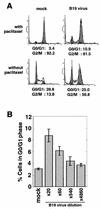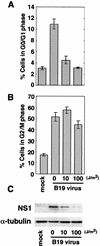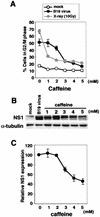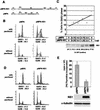Human parvovirus B19 nonstructural protein (NS1) induces cell cycle arrest at G(1) phase
- PMID: 12584315
- PMCID: PMC149759
- DOI: 10.1128/jvi.77.5.2915-2921.2003
Human parvovirus B19 nonstructural protein (NS1) induces cell cycle arrest at G(1) phase
Abstract
Human parvovirus B19 infects predominantly erythroid precursor cells, leading to inhibition of erythropoiesis. This erythroid cell damage is mediated by the viral nonstructural protein 1 (NS1) through an apoptotic mechanism. We previously demonstrated that B19 virus infection induces G(2) arrest in erythroid UT7/Epo-S1 cells; however, the role of NS1 in regulating cell cycle arrest is unknown. In this report, by using paclitaxel, a mitotic inhibitor, we show that B19 virus infection induces not only G(2) arrest but also G(1) arrest. Interestingly, UV-irradiated B19 virus, which has inactivated the expression of NS1, still harbors the ability to induce G(2) arrest but not G(1) arrest. Furthermore, treatment with caffeine, a G(2) checkpoint inhibitor, abrogated the B19 virus-induced G(2) arrest despite expression of NS1. These results suggest that the B19 virus-induced G(2) arrest is not mediated by NS1 expression. We also found that NS1-transfected UT7/Epo-S1 and 293T cells induced cell cycle arrest at the G(1) phase. These results indicate that NS1 expression plays a critical role in G(1) arrest induced by B19 virus. Furthermore, NS1 expression significantly increased p21/WAF1 expression, a cyclin-dependent kinase inhibitor that induces G(1) arrest. Thus, G(1) arrest mediated by NS1 may be a prerequisite for the apoptotic damage of erythroid progenitor cells upon B19 virus infection.
Figures





Similar articles
-
Parvovirus B19 NS1 protein induces cell cycle arrest at G2-phase by activating the ATR-CDC25C-CDK1 pathway.PLoS Pathog. 2017 Mar 6;13(3):e1006266. doi: 10.1371/journal.ppat.1006266. eCollection 2017 Mar. PLoS Pathog. 2017. PMID: 28264028 Free PMC article.
-
Human Parvovirus B19 nonstructural protein transactivates the p21/WAF1 through Sp1.Virology. 2004 Nov 24;329(2):493-504. doi: 10.1016/j.virol.2004.09.008. Virology. 2004. PMID: 15518826
-
Human parvovirus B19 induces cell cycle arrest at G(2) phase with accumulation of mitotic cyclins.J Virol. 2001 Aug;75(16):7555-63. doi: 10.1128/JVI.75.16.7555-7563.2001. J Virol. 2001. PMID: 11462027 Free PMC article.
-
New Insights of Human Parvovirus B19 in Modulating Erythroid Progenitor Cell Differentiation.Viral Immunol. 2020 Oct;33(8):539-549. doi: 10.1089/vim.2020.0013. Epub 2020 May 15. Viral Immunol. 2020. PMID: 32412895 Review.
-
Parvovirus B19 and the pathogenesis of anaemia.Rev Med Virol. 2003 Nov-Dec;13(6):347-59. doi: 10.1002/rmv.395. Rev Med Virol. 2003. PMID: 14625883 Review.
Cited by
-
Nuclear entry and egress of parvoviruses.Mol Microbiol. 2022 Oct;118(4):295-308. doi: 10.1111/mmi.14974. Epub 2022 Aug 24. Mol Microbiol. 2022. PMID: 35974704 Free PMC article. Review.
-
Parvovirus b19 associated hepatitis.Hepat Res Treat. 2013;2013:472027. doi: 10.1155/2013/472027. Epub 2013 Oct 22. Hepat Res Treat. 2013. PMID: 24232179 Free PMC article. Review.
-
Duck hepatitis A virus type 1 mediates cell cycle arrest in the S phase.Virol J. 2022 Jun 27;19(1):111. doi: 10.1186/s12985-022-01839-6. Virol J. 2022. PMID: 35761382 Free PMC article.
-
Parvovirus B19 NS1 protein induces cell cycle arrest at G2-phase by activating the ATR-CDC25C-CDK1 pathway.PLoS Pathog. 2017 Mar 6;13(3):e1006266. doi: 10.1371/journal.ppat.1006266. eCollection 2017 Mar. PLoS Pathog. 2017. PMID: 28264028 Free PMC article.
-
Parvovirus infection-induced cell death and cell cycle arrest.Future Virol. 2010 Nov;5(6):731-743. doi: 10.2217/fvl.10.56. Future Virol. 2010. PMID: 21331319 Free PMC article.
References
-
- Abraham, R. T. 2001. Cell cycle checkpoint signaling through the ATM and ATR kinases. Genes. Dev. 15:2177-2196. - PubMed
-
- Asao, H., Y. Sasaki, T. Arita, N. Tanaka, K. Endo, H. Kasai, T. Takeshita, Y. Endo, T. Fujita, and K. Sugamura. 1997. Hrs is associated with STAM, a signal-transducing adaptor molecule: its suppressive effect on cytokine-induced cell growth. J. Biol. Chem. 52:32785-32791. - PubMed
-
- Astell, C. R., C. D. Mol, and W. F. Anderson. 1987. Structural and functional homology of parvovirus and papovavirus polypeptides. J. Gen. Virol. 68:885-893. - PubMed
-
- Ball, K. L. 1997. p21: structure and functions associated with cyclin-CDK binding. Prog. Cell Cycle Res. 3:125-134. - PubMed
-
- Blasina, A., B. D. Price, G. A. Turenne, and C. H. McGowan. 1999. Caffeine inhibits the checkpoint kinase ATM. Curr. Biol. 9:1135-1138. - PubMed
MeSH terms
Substances
LinkOut - more resources
Full Text Sources
Other Literature Sources
Research Materials

